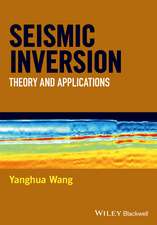GNSS Remote Sensing: Theory, Methods and Applications: Remote Sensing and Digital Image Processing, cartea 19
Autor Shuanggen Jin, Estel Cardellach, Feiqin Xieen Limba Engleză Hardback – 15 oct 2013
| Toate formatele și edițiile | Preț | Express |
|---|---|---|
| Paperback (1) | 784.53 lei 38-44 zile | |
| SPRINGER NETHERLANDS – 27 aug 2016 | 784.53 lei 38-44 zile | |
| Hardback (1) | 954.45 lei 43-57 zile | |
| SPRINGER NETHERLANDS – 15 oct 2013 | 954.45 lei 43-57 zile |
Din seria Remote Sensing and Digital Image Processing
- 18%
 Preț: 1020.74 lei
Preț: 1020.74 lei - 18%
 Preț: 1231.47 lei
Preț: 1231.47 lei - 18%
 Preț: 944.82 lei
Preț: 944.82 lei - 15%
 Preț: 530.42 lei
Preț: 530.42 lei - 24%
 Preț: 1613.55 lei
Preț: 1613.55 lei - 18%
 Preț: 1385.19 lei
Preț: 1385.19 lei - 24%
 Preț: 793.36 lei
Preț: 793.36 lei - 15%
 Preț: 640.37 lei
Preț: 640.37 lei - 18%
 Preț: 1112.15 lei
Preț: 1112.15 lei - 18%
 Preț: 1408.08 lei
Preț: 1408.08 lei - 15%
 Preț: 662.95 lei
Preț: 662.95 lei - 18%
 Preț: 1389.78 lei
Preț: 1389.78 lei - 24%
 Preț: 1476.62 lei
Preț: 1476.62 lei - 18%
 Preț: 1122.10 lei
Preț: 1122.10 lei - 18%
 Preț: 1407.64 lei
Preț: 1407.64 lei - 20%
 Preț: 988.27 lei
Preț: 988.27 lei - 18%
 Preț: 945.76 lei
Preț: 945.76 lei - 24%
 Preț: 802.74 lei
Preț: 802.74 lei - 15%
 Preț: 650.86 lei
Preț: 650.86 lei - 15%
 Preț: 650.37 lei
Preț: 650.37 lei - 15%
 Preț: 642.51 lei
Preț: 642.51 lei - 15%
 Preț: 653.46 lei
Preț: 653.46 lei
Preț: 954.45 lei
Preț vechi: 1163.97 lei
-18% Nou
Puncte Express: 1432
Preț estimativ în valută:
182.63€ • 191.20$ • 151.12£
182.63€ • 191.20$ • 151.12£
Carte tipărită la comandă
Livrare economică 07-21 aprilie
Preluare comenzi: 021 569.72.76
Specificații
ISBN-13: 9789400774810
ISBN-10: 9400774818
Pagini: 292
Ilustrații: XVI, 276 p. 102 illus., 56 illus. in color.
Dimensiuni: 155 x 235 x 21 mm
Greutate: 0.7 kg
Ediția:2014
Editura: SPRINGER NETHERLANDS
Colecția Springer
Seria Remote Sensing and Digital Image Processing
Locul publicării:Dordrecht, Netherlands
ISBN-10: 9400774818
Pagini: 292
Ilustrații: XVI, 276 p. 102 illus., 56 illus. in color.
Dimensiuni: 155 x 235 x 21 mm
Greutate: 0.7 kg
Ediția:2014
Editura: SPRINGER NETHERLANDS
Colecția Springer
Seria Remote Sensing and Digital Image Processing
Locul publicării:Dordrecht, Netherlands
Public țintă
ResearchCuprins
Introduction to GNSS.- Atmospheric delays and Multipath.- Ground-based GNSS Atmospheric Sensing.- Space-borne GNSS Atmospheric Sensing.- GNSS Reflectometry.- GNSS Ocean Remote Sensing.- GNSS Hydrology Sensing.- GNSS Cryosphere Sensing.
Recenzii
From the book reviews:
“The book shows the possibility of using GNSS technology for multidisciplinary research, which is addressed here to a wide audience, representing the community of GNSS, meteorologists, hydrologists and others, from the area of earth sciences. I highly recommend this book to students and researchers who wish to learn about how to think about new possibilities of using GNSS technology in monitoring of the earth.” (Jaroslaw Bosy, Pure and Applied Geophysics, Vol. 172, 2015)
“The book shows the possibility of using GNSS technology for multidisciplinary research, which is addressed here to a wide audience, representing the community of GNSS, meteorologists, hydrologists and others, from the area of earth sciences. I highly recommend this book to students and researchers who wish to learn about how to think about new possibilities of using GNSS technology in monitoring of the earth.” (Jaroslaw Bosy, Pure and Applied Geophysics, Vol. 172, 2015)
Notă biografică
Prof. Dr. Shuanggen Jin is employed at the Shanghai Astronomical Observatory, Chinese Academy of Sciences, Shanghai, China. He obtained his Ph.D. in GNSS and remote sensing in 2003 at the Chinese Academy of Sciences. His areas of expertise include satellite navigation and positioning, remote sensing and climate change and space/planetary sensing and dynamics. As of July 2011, he is a Fellow of the International Association of Geodesy (IAG). He works as an editor for a lot of journals, and acts as the Editor-in-Chief for International Journal of Geosciences.
Textul de pe ultima copertă
The versatile and available GNSS signals can detect the Earth’s surface environments as a new, highly precise, continuous, all-weather and near-real-time remote sensing tool. This book presents the theory and methods of GNSS remote sensing as well as its applications in the atmosphere, oceans, land and hydrology. Ground-based atmospheric sensing, space-borne atmospheric sensing, reflectometry, ocean remote sensing, hydrology sensing as well as cryosphere sensing with the GNSS will be discussed per chapter in the book.
Caracteristici
Contains detailed theory and study cases to help the reader put the material into practice Contains a special chapter on next generation GNSS-RS, which is are seen as the future in GNSS Describes new potentials as well as advantages that complement existing techniques














